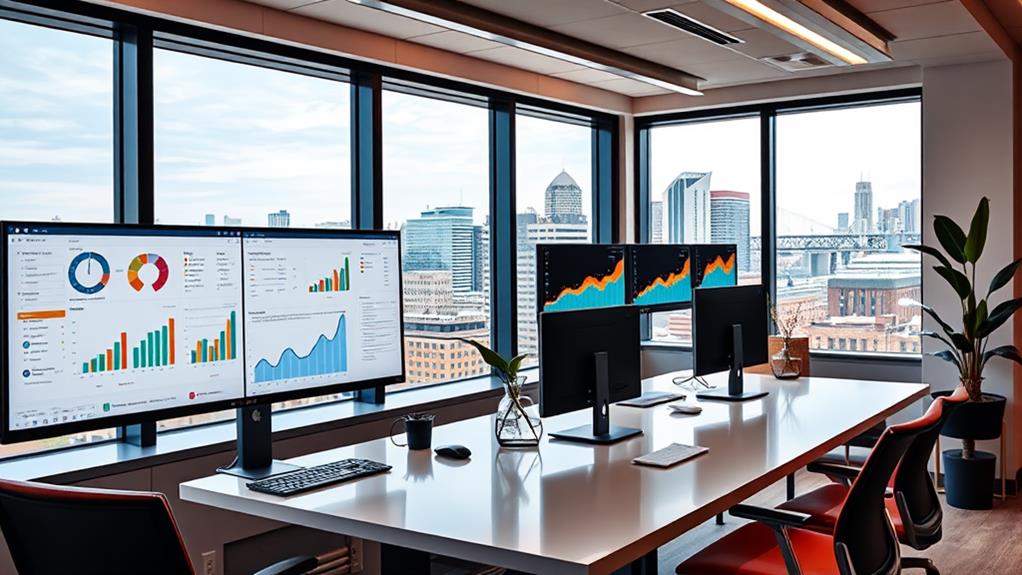Website costs can vary widely, ranging from a few hundred dollars for basic DIY solutions to tens of thousands for custom-built professional designs. You'll need to evaluate factors such as design complexity, functionality requirements, and development approach. Basic websites for small businesses or personal use may cost $500-$5,000, while more advanced designs with custom features can range from $5,000-$30,000 or more. Hourly rates for web designers typically fall between $50-$200, depending on experience and location. Don't forget to factor in ongoing expenses like hosting, maintenance, and security updates. Understanding these cost components will help you make an informed decision about your website investment.
Price Range for Web Design
When considering the price range for web design, you'll find significant variation based on several factors. Just like with building and construction services, you'll need to weigh the complexity of your desired design, from basic layouts to advanced, feature-rich websites, which can drastically impact the cost.
The level of project management expertise, similar to what's needed in construction, will also affect the pricing. Additionally, you should consider whether you're comfortable with DIY website builders or if you'd prefer to invest in professional services, keeping in mind that pricing models can range from hourly rates to fixed project fees.
Basic Vs. Advanced Designs
In today's digital landscape, website designs fall into two broad categories: basic and advanced. Basic designs typically offer a simpler, more straightforward approach, while advanced designs incorporate complex features and functionalities. When deciding between the two, consider your business needs, target audience, and budget.
Basic designs are often suitable for:
- Small businesses or startups
- Personal blogs or portfolios
- Informational websites
- Local service providers
These designs usually cost less and are quicker to develop but may lack sophisticated features. Advanced designs, on the other hand, cater to larger businesses, e-commerce platforms, or content-heavy sites. They offer enhanced user experiences, custom functionalities, and scalability.
What distinguishes advanced designs? They often include responsive layouts, interactive elements, advanced SEO optimization, and integration with third-party services. While these features can noticeably boost your online presence, they come at a higher price point. How do you determine which option is right for you? Assess your long-term goals, evaluate your competition, and consider your target audience's expectations. Remember, a well-designed website, whether basic or advanced, should effectively communicate your brand's message and meet your specific business objectives.
Hourly Vs. Fixed Pricing
You'll encounter two main pricing models when seeking web design services: hourly and fixed pricing. Hourly rates typically range from $50 to $200 per hour, depending on the designer's experience and location. This model offers flexibility but can lead to unpredictable costs. How many hours will your project require? It's vital to establish clear expectations and regular check-ins to avoid budget overruns.
Fixed pricing, on the other hand, provides a set cost for the entire project. This approach can range from $500 for a basic website to $20,000 or more for complex, custom designs. While this model offers cost certainty, it's indispensable to define the project scope meticulously. What features are included? How many revisions are allowed? Be aware that changes outside the agreed-upon scope may incur additional charges.
When deciding between these models, consider your project's complexity, budget constraints, and risk tolerance. Hourly pricing might suit projects with evolving requirements, while fixed pricing is often preferable for well-defined projects. Remember, the cheapest option isn't always the best value. Focus on finding a balance between cost, quality, and your specific needs.
DIY Vs. Professional Services
The decision between DIY and professional web design services can greatly impact your budget and final product. When considering DIY options, you'll find platforms like Wix, Squarespace, and WordPress offering user-friendly interfaces and templates. These can cost anywhere from $0 to $500 annually, depending on the plan and features you choose. However, professional services typically range from $1,000 to $100,000+, reflecting the expertise and customization involved.
Before making your choice, consider these factors:
- Your technical skills and available time
- The complexity of your desired website
- Your budget constraints
- The importance of a unique, branded design
Professional services offer tailored solutions, ensuring your site aligns perfectly with your brand and goals. They'll handle complex functionalities, responsive design, and SEO optimization. However, this expertise comes at a higher cost.
DIY platforms, while more affordable, may limit your design options and require a significant time investment to learn and implement effectively.
Ultimately, your decision should balance cost, time, and desired outcome. For simple informational sites, DIY platforms may suffice. But for e-commerce, custom functionality, or a highly polished look, professional services often provide the best value, despite the higher initial investment.
Benefits
Investing in a website offers numerous advantages for your business beyond mere online presence. For instance, if your business specializes in deck construction and customization, having a well-designed website showcasing your custom-designed decks and how they integrate seamlessly with home architecture can significantly enhance your credibility. Potential customers often judge a company's legitimacy by its web presence.
Additionally, your website provides round-the-clock accessibility, allowing clients to engage with your brand at any time. Likewise, a well-designed website serves as a cost-effective marketing tool, showcasing your products or services to a global audience and potentially increasing your customer base without the ongoing expenses associated with traditional advertising methods.
Enhanced Online Presence
A well-designed website can catapult your business into the digital spotlight, enhancing your online presence and opening doors to countless opportunities. When you invest in a professional website, you're not just creating a virtual storefront; you're establishing a powerful tool that works 24/7 to represent your brand and engage potential customers.
Your enhanced online presence will provide:
- Increased visibility in search engine results
- A platform for showcasing your products or services
- Improved credibility and trust with your target audience
- The ability to reach a global market
Increased Business Credibility
Stepping up your online game with a professional website can enormously boost your business's credibility. In today's digital landscape, potential customers often form their first impression of your company based on your online presence. A well-designed, functional website serves as a digital storefront, showcasing your products, services, and brand identity 24/7.
24/7 Accessibility
With accessibility at the forefront of web design, you're opening doors to a wider audience and reaping numerous benefits. By ensuring your website is accessible to people with disabilities, you're not only complying with legal requirements but also expanding your potential customer base. Accessible websites often provide a better user experience for all visitors, leading to increased engagement and satisfaction.
Consider these key advantages of prioritizing accessibility:
- Improved search engine optimization (SEO)
- Enhanced brand reputation and social responsibility
- Reduced legal risks and potential lawsuits
- Increased market reach and customer loyalty
Implementing accessibility features, such as alternative text for images, keyboard navigation, and proper color contrast, can notably impact your website's usability. Have you considered how these elements might affect your site's performance? By investing in accessibility, you're creating a more inclusive online presence that caters to diverse user needs. This approach not only demonstrates your commitment to equal access but also positions your business as forward-thinking and user-centric. Remember, an accessible website is often a more usable website for everyone, regardless of ability. How might this investment in accessibility translate to improved customer satisfaction and, ultimately, your bottom line?
Cost-Effective Marketing Tool
Your website serves as a round-the-clock marketing powerhouse, offering unparalleled cost-effectiveness compared to traditional advertising methods. Unlike print ads or billboards, which have limited exposure and high recurring costs, your website continuously promotes your brand, products, and services to a global audience. Have you considered the long-term return on investment a well-designed website can provide?
By implementing search engine optimization (SEO) strategies, you can improve your site's visibility in search results, attracting organic traffic without ongoing advertising expenses. How much would you save on pay-per-click campaigns by ranking higher naturally? Additionally, your website can showcase customer testimonials, detailed product information, and engaging content, nurturing leads and building trust with potential clients. Can you imagine the impact of a 24/7 sales representative working tirelessly to convert visitors into customers?
Furthermore, your website enables cost-effective email marketing campaigns, social media integration, and content marketing initiatives. By leveraging these digital marketing tools, you can reach your target audience more efficiently and measure your efforts' success through analytics. Isn't it time to harness the full potential of your website as a cost-effective marketing tool?
Website Hosting and Maintenance Costs
When considering website costs, you'll need to factor in ongoing expenses for hosting and maintenance. Your hosting plan options can range from shared servers to dedicated solutions, each with different price points and features. Regular maintenance tasks, including content updates, backups, and performance optimization, are essential for keeping your site running smoothly and securely.
| Hosting Type | Price Range | Best For |
|---|---|---|
| Shared | $3-$20/mo | Small sites |
| VPS | $20-$100/mo | Medium sites |
| Dedicated | $100+/mo | Large sites |
| Cloud | Varies | Scalable needs |
Hosting Plan Options
Reliability forms the backbone of any successful website, and choosing the right hosting plan is essential for maintaining that stability. When selecting a hosting plan, you'll encounter several options tailored to different needs and budgets. Consider the following factors:
- Shared hosting: Ideal for small websites with moderate traffic
- Virtual Private Server (VPS): Offers more resources and control for growing sites
- Dedicated server: Provides maximum performance and customization for high-traffic websites
- Cloud hosting: Scalable solution with distributed resources for flexibility
Each option comes with its own set of advantages and limitations. Shared hosting, while cost-effective, may limit your site's performance during traffic spikes. VPS hosting offers a balance between affordability and performance, allowing you to scale resources as needed.
Dedicated servers provide unparalleled control but require more technical expertise and higher costs. Cloud hosting, on the other hand, offers excellent scalability and reliability, but pricing can fluctuate based on usage.
How do you determine which plan is right for your website? Assess your current needs, anticipated growth, and budget constraints. Don't hesitate to consult with hosting providers to discuss your specific requirements and explore potential upgrade paths as your website evolves.
Regular Maintenance Tasks
Once you've selected the right hosting plan, it's important to factor in the ongoing costs of website maintenance. Regular maintenance tasks are critical for keeping your site secure, functional, and up-to-date.
These tasks typically include updating your content management system (CMS), plugins, and themes to patch security vulnerabilities and guarantee compatibility with the latest web technologies.
You'll also need to perform regular backups of your website's files and database to protect against data loss. Additionally, monitoring your site's performance, analyzing traffic patterns, and optimizing load times are essential for providing a smooth user experience.
How often should you conduct these maintenance tasks? It's recommended to perform updates and backups at least monthly, while performance monitoring should be ongoing.
Many website owners choose to outsource these maintenance tasks to professionals, which can cost anywhere from $50 to $500 per month, depending on the size and complexity of your site. Alternatively, if you have the technical skills, you can handle these tasks yourself, but be prepared to invest several hours each month.
Security and Updates
Security and updates form a vital component of your website's hosting and maintenance costs. These elements are indispensable for protecting your site from cyber threats and ensuring optimal performance. You'll need to factor in regular security audits, software updates, and patching vulnerabilities to maintain a secure online presence. The costs associated with these measures can vary depending on your website's complexity and the level of protection required.
Consider the following security and update-related expenses:
- SSL certificate renewal
- Firewall and malware protection
- Regular backups and restoration services
- Software and plugin updates
How often should you update your website's security measures? It's recommended to perform security checks and updates at least monthly, if not more frequently. Are you using a content management system like WordPress? If so, you'll need to budget for routine core updates and plugin maintenance. What about custom-coded websites? These may require more specialized attention and potentially higher costs for security updates.
Frequently Asked Questions
How Long Does It Typically Take to Design and Launch a Website?
You'll find website design and launch timelines vary widely. A simple site might take 2-4 weeks, while complex projects can span several months. Your specific needs, content readiness, and designer's availability all impact the duration.
Can I Update the Website Content Myself After It's Built?
Yes, you can usually update your website content yourself after it's built. Many websites use content management systems (CMS) that allow you to easily edit text, images, and other elements without needing coding knowledge.
What's the Difference Between Custom-Built Websites and Template-Based Solutions?
Custom-built websites are tailored to your specific needs, offering unique designs and functionality. Template-based solutions use pre-designed layouts, which you can customize. Custom sites provide more flexibility but are pricier, while templates are faster and more affordable.
Do I Need to Purchase a Domain Name Separately?
Yes, you'll typically need to purchase a domain name separately from your website. It's your unique web address. You can buy it from domain registrars or sometimes through your web hosting provider. Prices vary but are generally affordable.
How Often Should I Redesign or Update My Website?
You should redesign or update your website every 2-3 years to keep it fresh and relevant. However, you'll want to make minor updates more frequently, like invigorating content, fixing bugs, and improving functionality as needed.







